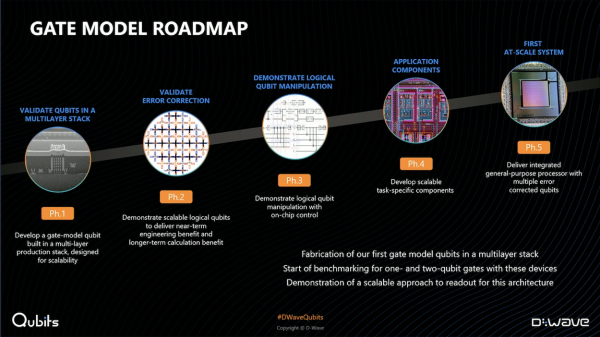At yesterday’s opening keynote to D-Wave Systems’ annual Qubits23 conference, CEO Alan Baratz took a broad swipe at the gate-based quantum computing community and declared D-Wave, a pioneer in quantum annealing-based computing, is delivering business value now. No waiting required.
“Often you’ll hear quantum computing is complex and that we’re years away from actually being able to use quantum computers. But that’s FUD – fear, uncertainty, and doubt – propagated by those in the industry that are years away from having quantum computers that can actually solve real world problems. That’s not the case with D-Wave. We chose a quantum path that has allowed us to get to commercial first, and years ahead of anybody else,” said Baratz.
“The truth is, quantum encompasses more than just gate model computing. We chose annealing because it’s a much easier technology to work with. It’s easier to scale. It’s less sensitive to noise and errors, and it has allowed us to become commercial, years ahead of everybody else. Moreover, annealing quantum computers are excellent at solving optimization problems, things like employee scheduling, or shipping container unloading and loading, or even protein folding. So despite what you might hear from industry pundits with big megaphones, the era of commercial quantum computing is here today, and D-Wave is leading the charge, not something that you need to plan for tomorrow like with gate model systems.”

That’s a bold claim, but perhaps understandable given that 20-plus-year-old D-Wave has often been portrayed as a kind of step-child in the quantum computing community with limited compass. Not only is this not the case, argues Baratz, but it turns out that quantum annealing can be used effectively beyond optimization problems while gate-based models will never be as good at optimization problems.
Citing a Boston Consulting Group study, Baratz said “[BCG] divided that market into four technology areas: optimization, linear algebra, factorization, and differential equations. Optimization [encompasses] the kinds of problems I talked about a few minutes ago, fraud detection, protein folding, painting vehicles on a manufacturing floor. Linear algebra is essentially machine learning. Factorization is crypto. Differential equations are for things like quantum chemistry and computational fluid dynamics. BCG estimated that about a quarter of the total addressable market is in each of those four areas.
“With our annealing quantum computers, we absolutely address optimization. We nail that and it’s unlikely that gate model systems will ever deliver speed-up on optimization problems. But annealing can also address linear algebra and factorization. It cannot address differential equations. That’s the one area that annealing quantum computers cannot address. Gate-model systems are very good at differential equations, they can also do linear algebra, [and] they can also do factorization, but they cannot do optimization.”
Annual user meetings are always filled with competitive zeal, but one has the sense that Baratz thinks it’s time for D-Wave to strut its stuff.
While technology updates were also presented at Qubits23, being held in Miami this week as a hybrid in-person/digital event, the clear emphasis is on use cases, commercial partners, and efforts to entice early users with the promise of near-term business value. In his keynote, Baratz presented mini-case histories with live demos from MasterCard, Deloitte, SLB (formerly Schlumberger) and Davidson Technology. In each case, calls were made live to the D-Wave quantum annealing computer, though not all the apps are in production.
 Early in his talk, Baratz brandished a Wall Street Journal with a big D-Wave advertisement headlined, “Put Your Business in Superposition; use quantum computing to improve critical business operations today.”
Early in his talk, Baratz brandished a Wall Street Journal with a big D-Wave advertisement headlined, “Put Your Business in Superposition; use quantum computing to improve critical business operations today.”
“Normally, I would not spring for an ad in the Wall Street Journal, but as I think you all know, we did go public on August 8, listed on the New York Stock Exchange. And when you’re listed on the New York Stock Exchange, they provide some incentives and one of the incentives was a free Wall Street Journal ad, and we decided to time it with Qubits.”
There was also plenty of tech talk, though not especially granular. D-Wave’s next big quantum annealing computer – Advantage2 – is on schedule for launch in the 2023/24 timeframe. Advantage2 will feature 7000-plus qubits, a new qubit topology (Zephyr), and a new fabrication process. Early ~500 qubit prototypes are already outperforming the first Advantage architecture and have been made available through D-Wave’s Leap Quantum Cloud Service. There was no clarification of the final launch date, but Emile Hoskinson, director of quantum annealing products, suggested progress was moving faster than expected, so maybe this year.



About D-Wave’s gate-based quantum development effort, Baratz said, “We fabricated multi-layer gate model qubits. We are now benchmarking one- and two-qubit gates on those qubits. We’ve put control on the same chip as the qubits and demonstrated much more efficient readout than anybody else has been able to achieve, and we’ve just completed the design of our first logical qubit able to support error correction. We’ve also introduced the gates simulator into our Ocean tool suite. And now you can start programming gate model applications within Ocean. You can construct circuits, you’ve got a flexible content manager, a comprehensive gate library, and you can create your own gates.”
There were few technology details presented about the gate-based development. D-Wave doesn’t expect to field a gate-based system that users could access for many years, said Hoskinson. (Primer on D-Wave quantum annealing gate versus gate-based computing). It is worth noting that quantum annealing approaches to solving optimization problems have been more widely embraced in recent years by quantum computer companies (QuEra is one) and traditional computer companies (Fujitsu is one) using digital techniques.

Baratz walked quickly through some company numbers. D-Wave had 63 commercial customers at the end of Q3 last year, a 24 percent jump over the same first three quarters last year. More than two dozen of those are Forbes Global 2000 companies, said Baratz. More than 32 million jobs were submitted to D-Wave’s Leap Cloud Service in 2022, a 66 percent gain over 2021. Revenue from its quantum computer as-a-service (Leap) grew 34 percent YOY and now comprises 79 percent of revenue. The D-Wave developer ecosystem now has more than 34,000 members. Leap is available now in 38 countries, as well as through the AWS Marketplace.
The core of Baratz presentation was comprised of the use-case examples. In each case, Baratz presented the problem to the company. First up was MasterCard, with Steve Flinter, vice president of artificial intelligence and machine learning, handling the demo. The problem, an optimization task, was to choose the best sets of credit card offers to send to a set of customers based on their demographics and behavior patterns. “We’re going to use 100 cardholders and we’re going to give four offers per cardholder,” said Flinter.
MasterCard ran the problem using both a heuristic “greedy algorithm” run on a classical system and reformulated the problem to run on D-Wave’s system. The jobs were submitted and according to this simulation, the offer picked by the quantum annealer would yield $150,000 in sales versus $96,000 using the classically derived offer – an improvement of $55,000. Flinter said it is possible to dig even deeper into preferences and user behavior with the approach used on the D-Wave system. MasterCard is looking at how to scale up this application.

Deloitte tackled a problem that is (unfortunately) familiar to many conference goers – managing security workforce deployments at airports. Kate Abrey, principal at Deloitte, performed this demo. The problem was described by Baratz, “I’m with a large government agency and basically, we’ve got a massive scheduling problem for security at airports. Actually, we have over 60,000 employees and we have to schedule them into 450 different airports. It’s a huge challenge, because there are many, many factors that we need to consider; in fact, it’s so challenging that we’re typically creating schedules, six months in advance.”
Abrey noted it typically takes weeks to develop these schedules, and a wide variety to complicating factors (weather, personnel sickness, etc.) inevitably arise long after the schedules have been created. Deloitte has been developing an app to handle the problem, again, an optimization task, that uses the D-Wave computer.
“Using the quantum annealer these [scheduling jobs] can be done in real-time very easily. So, what you see here [on the demo screen] is one airport with over five lanes and 900 different people. And if I click you can see the different shifts. It’s pretty complicated. You have to have different genders, you need to have different levels of experience, and there are all sorts of different things like holiday schedules, people that work night-shifts, and day-shifts for us to calibrate. What we’ve done, using the D-Wave technology and partnering with the Savannah College of Art and Design is create an app with a very intuitive and human-centered approach to scheduling that can be done in just seconds,” she said.
As a demonstration, Baratz asked what would happen if suddenly 10 percent of the workforce was unavailable. Abrey ran the problem in real-time, remotely calling a D-Wave system, and produced a new schedule in seconds.

The example from Davidson Technologies was outright scary and re-assuring at the same time. Davidson has developed an app to orchestrate defense against a missile attack.
“The first thing I want to say is that everything you’re going to see here is notional and unclassified,” noted Dale Moore, chief operating officer at Davidson. “What you see here is a threat situation. Hawaii is being aggressed upon and we are preparing for an operational scenario to defend Honolulu. We’re going to run this scenario very simply. [The app] is now reaching out to the D-Wave quantum annealer, with our algorithms, running an optimization problem, this is what we call weapon-to-target-assignment optimization.”
“These threats can be very complex when you think about missile defense, and all the components of it [including] targeting, tracking, and engagement. What we’re going to do is we’re going to increase the complexity of the scenario itself, we’re going to add to long range ballistic missiles here and other items, and we’re going to go ahead and rerun this same scenario. Before we do that, we’re going to modify the parametric inputs, we’re going to decrease the effectiveness of the reactors. We’re going to ask about atmospheric rain, solar flare activity has an impact on performance, and now we’re going to rerun this scenario, again, reaching out to the D wave system. As you can see, it takes a little bit longer,” he said.
It didn’t take much longer. This is certainly what you’d call a mission-critical application.
As explained by Moore, the first scenario ran over 4,000 possible solutions. This second scenario had over 67 million. “As things get more complex, it is really important from our perspective, to leverage the best processing capabilities in the world and in optimizing solutions leveraging Davidson algorithms,” he said.
The fourth use case was presented by SLB. It was also an optimization problem. In this case, the goal was to organize the fastest and most cost-effective way to drill 30 oils wells in 88 days. The variables include moving the giant drilling rigs from site to site, using the fewest number of rigs and crews possible to get the job done, and quickly exploring how to do this by changing the variables. It’s another classic optimization problem.
SLB has developed an application to do this, which was demonstrated by Rod Lessard, software engineer, SLB.
“For this demo we’ll simulate the data by specifying the number of wells (30). Now the planning tool controls allow us to specify the number of rigs that are available and the number of crews that we’re going to assign. Finally, the solver controls down at the bottom allow the user to specify the weighting factors, whether they’re trying to minimize the problem makespan (time to finish the job) or the CO2 emissions resulting from the rig travel or the amount of rig idle time,” said Lessard. It took a few iterations to cost-effectively meet the 88-day makespan requirement.
The demos were all impressive and presumably outperformed classical systems.
The Qubits23 meeting drew 100 in-person attendees with another 3,000 registered for online participation, according to Baratz. The agenda was full, and D-Wave said the videoed sessions will be available on its YouTube channel in a couple of weeks.
Source By https://www.hpcwire.com/2023/01/18/qubits23-d-wave-asserts-the-quantum-wait-is-over/




